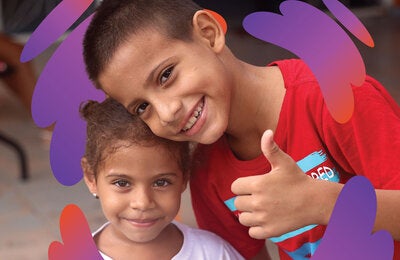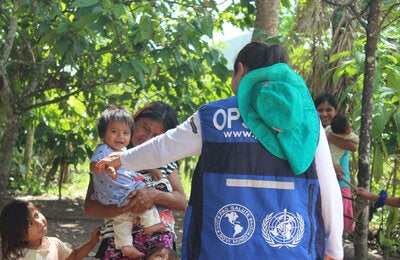
Sao Paulo, Brazil, 03 June 2020 (PAHO/WHO) - Evidence Map is an emerging method of knowledge translation that aims to synthesize, identify, describe, and characterize the scientific evidence that exists for a specific topic or health condition. Knowledge translation is one of the strategies that contributes to narrowing the historical gap that exists between available scientific knowledge and the adoption of this knowledge by health systems and services at all levels.
Recently, BIREME adopted and adapted this methodology to systematize and facilitate access to available evidence on the clinical applicability of Integrative and Complementary Health Practices (ICPs), as well as identify gaps in knowledge in this area. One of the maps systematized the evidence available from reviews and randomized clinical studies on the application of some integrative practices in the clinical handling of COVID-19 symptoms, for improving immunity and for mental health in conditions of social isolation and trauma. This map was the basis of the National Health Council’s recommendation to the Ministry of Health, the State Councils, the Federal District and Health Municipalities, in the sense of wide dissemination to managers, workers and users of the evidence referring to the ICPs during this moment of the COVID-19 pandemic.
Creating Evidence Maps
In the Evidence Maps, the selected studies are presented in a structure of interventions evaluated against measured results or outcomes, visually highlighting the gaps where there are few or no studies and where there is a concentration of them.
BIREME, taking into consideration the model Evidence Gap Map of the International Initiative for Impact Evaluation (3ie), generated a methodology for creating Evidence Maps linked to the information sources of the Virtual Health Library (VHL).
The motivation for this development was the cooperation established between PAHO/WHO, through BIREME, and the Ministry of Health (MS) of Brazil, through the National Coordination of Integrative and Complementary Health Practices (ICPs), with the collaboration of the Brazilian Academic Consortium for Integrative Health (CABSIn), with the goal of systematizing and facilitating access to the evidence available on the clinical applicability of ICPs included in the National Policy on Integrative and Complementary Practices in SUS (PNPIC), as well as identifying the gaps in knowledge; and, as a result, supporting health professionals, decision-makers, and researchers in the construction of evidence-based actions in health.
The first phase of the project served as proof of concept for the production of nine Evidence Maps[1]: Acupuncture, Auriculotherapy, Phytotherapy, Meditation, Oral Ozone Therapy, Traditional Chinese Practices, Reflexology, Shantala and Yoga. The outcomes were divided into groups: Physical and Metabolic Effects – Pain, Chronic Diseases, Acute Diseases and Cancer; Vitality, Well-Being and Quality of Life; Mental health; Socio-Environmental and Spirituality; and management. For each practice, a working group with researchers was created, which carried out the systematic search of documents in the main databases, selection of studies according to the pre-established criteria and subsequent characterization of the evidence. The maps are available at the VHL TCIM page.
At the root of this experience and in the face of the COVID-19 pandemic, CABSIn, the Network of Traditional, Complementary and Integrative Medicine of the Americas (TCIM Americas Network) and BIREME joined forced and called on volunteer researchers from Latin America to systematize the scientific evidence on possible contributions of TCIM to COVID-19, which were grouped according to the following results: Improved immunity and antiviral effects in respiratory viruses; Complementary treatment of respiratory infection symptoms; and Contributions to mental health. The map includes 126 review studies and controlled clinical studies, which were characterized in 62 interventions distributed in 5 groups: medicinal plants/phytotherapy; Traditional Chinese medicine; mind-body therapies; probiotics and nutritional supplements; and energized, homeopathic and anthroposophical medicines. This map is available in Portuguese, English, and Spanish.
In addition to the maps in the area of TCIM, the Methodology was applied in a review on Strategies to Reduce Health Inequalities and two other reviews are in the elaboration phase: the Clinical Application of Laser Therapy in Oral Health, and Antibiotic Prophylaxis for Surgical Procedures.
According to Daniel Amado, coordinator of the area of ICPs at MS, “the evidence maps are already being utilized by the National Coordination and are being structured for public policy.”
On the Evidence Maps Methodology
The production of Evidence Maps takes place in two macro steps: 1) search, selection and characterization of the evidence and 2) processing, treatment and visualization of data, resulting in the publication of the Map on the Internet.
The first step results in the construction of a data spreadsheet, using the tool Microsoft Excel, which records the characterization of the evidence by intervention and outcome, through parameters of confidence level, study design, type of review, population, effects and country/region of focus.
The second step processes the characterization of evidence spreadsheet, resulting in a standardized data source that is used in the elaboration and online publication of the Evidence Map, utilizing the Tableau Prep, Tableau Desktop and Tableau Public tools.
The methodology created in the first phase of the project, from the adoption and adaptation of the 3ie Evidence Gap Map model, aimed to flexibilize and simplify the processing and use of technology for the recording of evidence characterization. After the publication of these ten maps, both the developed methodology and the adopted tools will be reviewed to improve and scale the production and publication of Evidence Maps.




